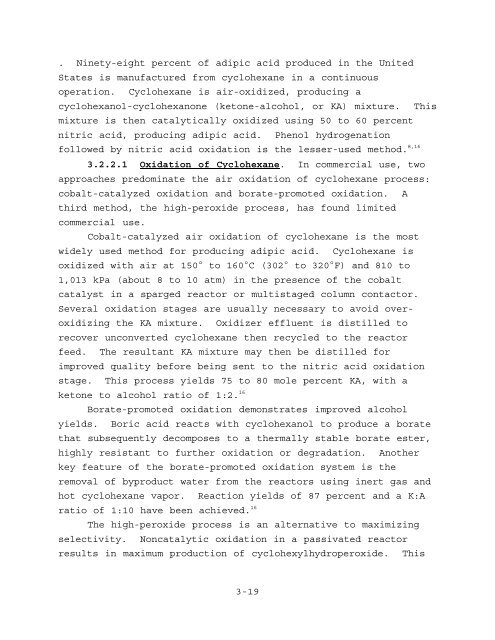Alternative Control Techniques Document— Nitric And Adipic Acid
Alternative Control Techniques Document— Nitric And Adipic Acid
Alternative Control Techniques Document— Nitric And Adipic Acid
You also want an ePaper? Increase the reach of your titles
YUMPU automatically turns print PDFs into web optimized ePapers that Google loves.
. Ninety-eight percent of adipic acid produced in the United<br />
States is manufactured from cyclohexane in a continuous<br />
operation. Cyclohexane is air-oxidized, producing a<br />
cyclohexanol-cyclohexanone (ketone-alcohol, or KA) mixture. This<br />
mixture is then catalytically oxidized using 50 to 60 percent<br />
nitric acid, producing adipic acid. Phenol hydrogenation<br />
followed by nitric acid oxidation is the lesser-used method. 8,16<br />
3.2.2.1 Oxidation of Cyclohexane. In commercial use, two<br />
approaches predominate the air oxidation of cyclohexane process:<br />
cobalt-catalyzed oxidation and borate-promoted oxidation. A<br />
third method, the high-peroxide process, has found limited<br />
commercial use.<br />
Cobalt-catalyzed air oxidation of cyclohexane is the most<br />
widely used method for producing adipic acid. Cyclohexane is<br />
oxidized with air at 150E to 160EC (302E to 320EF) and 810 to<br />
1,013 kPa (about 8 to 10 atm) in the presence of the cobalt<br />
catalyst in a sparged reactor or multistaged column contactor.<br />
Several oxidation stages are usually necessary to avoid over-<br />
oxidizing the KA mixture. Oxidizer effluent is distilled to<br />
recover unconverted cyclohexane then recycled to the reactor<br />
feed. The resultant KA mixture may then be distilled for<br />
improved quality before being sent to the nitric acid oxidation<br />
stage. This process yields 75 to 80 mole percent KA, with a<br />
ketone to alcohol ratio of 1:2. 16<br />
Borate-promoted oxidation demonstrates improved alcohol<br />
yields. Boric acid reacts with cyclohexanol to produce a borate<br />
that subsequently decomposes to a thermally stable borate ester,<br />
highly resistant to further oxidation or degradation. Another<br />
key feature of the borate-promoted oxidation system is the<br />
removal of byproduct water from the reactors using inert gas and<br />
hot cyclohexane vapor. Reaction yields of 87 percent and a K:A<br />
ratio of 1:10 have been achieved. 16<br />
The high-peroxide process is an alternative to maximizing<br />
selectivity. Noncatalytic oxidation in a passivated reactor<br />
results in maximum production of cyclohexylhydroperoxide. This<br />
3-19

















